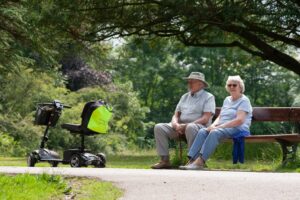Moving through public spaces isn’t always straightforward. From tight doorways to uneven paving, everyday tasks can become less manageable without the right support. People often talk about access as if it’s only a concern for a small group, but mobility needs can shift quickly and unexpectedly.
Staying independent often comes down to having tools that match your needs. That can mean making small adjustments or finding something more supportive. Everyone deserves to move comfortably through their day without unnecessary stress.
Small Barriers That Make a Big Difference
A single step at a shop entrance. A broken lift at a train station. These issues often go unnoticed unless they directly affect your routine. They’re annoying for someone using a walking frame or pushing a pram. For someone who relies on mobility equipment, they’re a sign to turn back.
Mobility scooters are designed to handle outdoor movement more effectively, but that doesn’t mean the environment cooperates. Pavement gradients, street furniture, and weather conditions can affect how easily and safely you travel. Supermarkets might have wide aisles, but getting there across narrow footpaths or steep kerbs is different.
Independence relies on more than ownership of a device. It also depends on how well public spaces accommodate it. That means smoother paths, more benches for rest, working lifts and reliable signage. Local councils may have guidelines, but implementation varies. A practical adjustment in one neighbourhood might be missing altogether in another.
Why Reliable Mobility Aids Are More Than a Convenience
Mobility aids are often viewed as optional or temporary. That perception doesn’t reflect how vital they are for people trying to keep control over their routines. Choosing the right equipment makes it easier to handle shopping, socialising and medical appointments without needing help every step of the way.
A disability scooter, for instance, can support consistent independence throughout the day. It reduces reliance on others, allows people to manage time more freely and helps maintain confidence. Knowing you can get to the post office, the bus stop or a friend’s house without worrying about stamina or safety is no small thing.
There’s also the question of what’s available nearby. Searching for disability scooters for sale might reveal a wide range online, but the local supply can be more limited. Testing a scooter in person is often useful, especially when dealing with weight capacity, turning radius or foldability.
Choosing the Right Support to Stay Active
Picking the right mobility aid involves more than checking a spec sheet. Think about the places you go to regularly. Do you visit indoor shopping centres, or is your area mostly residential with narrow pavements? Do you travel by car, and will the device need to be folded or dismantled for storage?
People often compare different models when searching for a mobility scooter for sale, but features like adjustable seating, battery range and control layout matter more than brand names or visual design. Test drives and demonstrations help identify what feels comfortable and manageable.
Some users rely on electric scooters for independence, which support daily errands, visits to family, or even short commutes. These options can restore a sense of reliability and rhythm to the week. The key is finding something that works for your speed, strength, and local terrain.
Support doesn’t stop with the scooter. Look into storage solutions, protective covers, maintenance plans and insurance. Knowing your equipment is safe and serviceable removes another layer of stress. Good mobility shouldn’t create new administrative burdens or unexpected costs.
Public Policy Still Leaves Gaps
Try navigating a train station with a lift that’s out of service. Or reach a chemist with a step at the door and no ramp in sight. These aren’t rare problems; they’re daily obstacles for people who rely on mobility aids.
Policies about access exist, but following them on paper isn’t the same as delivering results on the ground. Some areas make progress, while others stay the same for years. A ramp without a push-button door doesn’t help much. And a dropped kerb placed next to a lamppost is worse than useless. These are the kinds of things that get missed when people making the decisions haven’t had to experience the challenge themselves.
You can’t always rely on public transport, either. A driver might refuse to deploy the ramp, or a station assistant might not show up. So many systems depend on people doing their job properly, which makes them unpredictable. That’s why local knowledge matters.
Community forums, mobility support groups, and word-of-mouth often give better info than transport websites. You’ll hear which stations to avoid, which bus routes are manageable, and where shop owners are helpful.
Your Independence Is Worth Protecting
If something becomes harder, walking long distances, getting out alone, or managing a whole day without support, that’s not a failure. It’s just a sign that your routine might need adjusting. You don’t have to wait until things feel impossible. Getting the right help early on can make a big difference.
Think about your usual week. Where do you go? What feels difficult? Do you need to carry bags? Are there stairs? Is public transport reliable enough, or does it add more effort than it’s worth?
These details help narrow things down. For some people, a walking stick or folding frame is enough. Others might benefit more from a lightweight mobility aid or something more robust for longer trips.
Ask questions. Compare models. Contact suppliers offering home demos or personal fittings if you’re unsure what works best. They’ll give you a better idea than a sales page ever could. Most importantly, don’t wait too long to act. The right support can keep you independent for years to come. You’re still in charge of your routine; this is just about making it easier.







